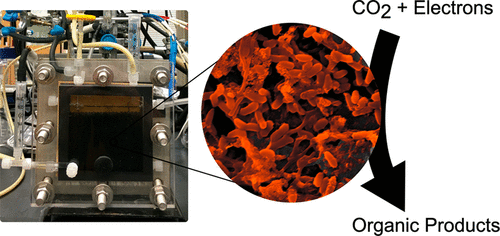当前位置:
X-MOL 学术
›
Acc. Chem. Res.
›
论文详情
Our official English website, www.x-mol.net, welcomes your feedback! (Note: you will need to create a separate account there.)
Microbiome for the Electrosynthesis of Chemicals from Carbon Dioxide.
Accounts of Chemical Research ( IF 16.4 ) Pub Date : 2019-12-06 , DOI: 10.1021/acs.accounts.9b00522 Edward V LaBelle 1 , Christopher W Marshall 2 , Harold D May 3
Accounts of Chemical Research ( IF 16.4 ) Pub Date : 2019-12-06 , DOI: 10.1021/acs.accounts.9b00522 Edward V LaBelle 1 , Christopher W Marshall 2 , Harold D May 3
Affiliation

|
The price for renewable electricity is rapidly decreasing, and the availability of such energy is expected to increase in the coming years. This is a welcomed outcome considering that mitigation of climate disruption due to the use of fossil carbon is reaching a critical stage. However, the economy will remain dependent on carbon-based chemicals and the problem of electricity storage persists. Therefore, the development of electrosynthetic processes that convert electricity and CO2 into chemicals and energy dense fuels, perhaps even food, would be desirable. Electrochemistry has been applied to the manufacture of many valuable products and at a large industrial scale, but it is difficult to produce multicarbon chemicals from CO2 by chemistry alone. Being that the biological world possesses expertise at the construction of C-C bonds, it is being examined in conjunction with electrochemistry to discover new ways of synthesizing chemicals from electricity and CO2. One approach is microbial electrosynthesis. This Account describes the development of a microbial electrosynthesis system by the authors. A biocathode consisting of a carbon-based electrode and a microbial community produced short chain fatty acids, primarily acetate. The device works by electrolysis of water, but microbes facilitate electron transfer from the cathode while reducing CO2 by the Wood-Ljungdahl pathway possessed by an Acetobacterium sp. While this acetogenic microorganism dominates the microbiome growing on the cathode surface, 13 total species of microbes overall were ecologically selected on the cathode and genomes for each have been assembled. The combined species may contribute to the stability of the microbiome, a common feature of naturally selected microbial communities. The microbial electrosynthesis system was demonstrated to operate continuously at a cathode for more than 2 years and could also be used with intermittent power, thus demonstrating the stability of the microbiome living at the cathode. In addition to the description of reactor design and startup procedures, the possible mechanisms of electron transfer are described in this Account. While mysteries remain to be solved, much evidence indicates that the microbiome may facilitate electron transfer by supplying catalyst(s) external to the bacterial cells and onto the cathode surface. This may be in the form of a hydrogen-producing catalyst that enhances hydrogen generation by an inert carbon-based electrode. Through the enrichment of the electrosynthetic microbiome along with several modifications in reactor design and operation, the productivity and efficiency were improved. In addition to the intrinsic value of the current products, coupling the process with a secondary stage might be used to produce more valuable products from the acetic acid stream such as lipids, biocrude oil, or higher value food supplements. Alternatively, additional work on the mechanism of electron transfer, reactor design/operation, and modification of the microbes through synthetic biology, particularly to enhance carbon efficiency into higher value chemicals, are the needed next steps to advance microbial electrosynthesis so that it may be used to transform renewable electrons and CO2 directly into products and help solve the problem of climate disruption.
中文翻译:

用于从二氧化碳电合成化学物质的微生物组。
可再生电力的价格正在迅速下降,并且在未来几年中,此类能源的可用性有望增加。考虑到减轻因使用化石碳导致的气候破坏正处于关键阶段,这是一个令人欢迎的结果。但是,经济仍将依赖于碳基化学品,并且电力存储问题仍然存在。因此,需要开发将电流和二氧化碳转化为化学物质和能量密集型燃料(甚至是食品)的电合成方法。电化学技术已被用于制造许多有价值的产品,并且已经大规模应用于工业领域,但是仅凭化学方法很难从CO2中生产多碳化学品。鉴于生物界在CC债券的构建方面拥有专业知识,正在与电化学结合进行研究,以发现从电和二氧化碳中合成化学物质的新方法。一种方法是微生物电合成。该报告描述了作者开发的微生物电合成系统。由碳基电极和微生物群落组成的生物阴极产生短链脂肪酸,主要是乙酸。该装置通过水的电解来工作,但是微生物通过醋杆菌属拥有的Wood-Ljungdahl途径,在促进电子从阴极转移的同时,减少了二氧化碳的排放。尽管这种产乙酸微生物控制着在阴极表面生长的微生物组,但在阴极上生态上总共选择了总共13种微生物,并且每种基因组都已组装好。合并的物种可能有助于微生物组的稳定性,这是自然选择的微生物群落的共同特征。微生物电合成系统被证明可以在阴极连续运行2年以上,并且还可以间歇使用,从而证明了生活在阴极的微生物组的稳定性。除了对反应堆设计和启动程序的描述之外,该帐户还介绍了电子转移的可能机理。尽管还有待解决的奥秘,但许多证据表明,微生物组可以通过在细菌细胞外部和阴极表面上提供催化剂来促进电子转移。这可以是产生氢气的催化剂的形式,其通过惰性碳基电极增强氢气的产生。通过丰富电合成微生物组以及对反应器设计和操作进行多次修改,提高了生产率和效率。除了当前产品的内在价值之外,该过程与第二阶段的结合可能还可以用于从乙酸物流中生产出更有价值的产品,例如脂质,生物原油或更高价值的食品补充剂。或者,需要进行进一步的工作,包括电子转移的机理,反应器的设计/操作以及通过合成生物学对微生物的修饰,特别是提高碳转化成高价值化学物质的效率,以促进微生物的电合成,以便可以使用它。将可再生电子和二氧化碳直接转化为产品,并帮助解决气候破坏问题。
更新日期:2019-12-07
中文翻译:

用于从二氧化碳电合成化学物质的微生物组。
可再生电力的价格正在迅速下降,并且在未来几年中,此类能源的可用性有望增加。考虑到减轻因使用化石碳导致的气候破坏正处于关键阶段,这是一个令人欢迎的结果。但是,经济仍将依赖于碳基化学品,并且电力存储问题仍然存在。因此,需要开发将电流和二氧化碳转化为化学物质和能量密集型燃料(甚至是食品)的电合成方法。电化学技术已被用于制造许多有价值的产品,并且已经大规模应用于工业领域,但是仅凭化学方法很难从CO2中生产多碳化学品。鉴于生物界在CC债券的构建方面拥有专业知识,正在与电化学结合进行研究,以发现从电和二氧化碳中合成化学物质的新方法。一种方法是微生物电合成。该报告描述了作者开发的微生物电合成系统。由碳基电极和微生物群落组成的生物阴极产生短链脂肪酸,主要是乙酸。该装置通过水的电解来工作,但是微生物通过醋杆菌属拥有的Wood-Ljungdahl途径,在促进电子从阴极转移的同时,减少了二氧化碳的排放。尽管这种产乙酸微生物控制着在阴极表面生长的微生物组,但在阴极上生态上总共选择了总共13种微生物,并且每种基因组都已组装好。合并的物种可能有助于微生物组的稳定性,这是自然选择的微生物群落的共同特征。微生物电合成系统被证明可以在阴极连续运行2年以上,并且还可以间歇使用,从而证明了生活在阴极的微生物组的稳定性。除了对反应堆设计和启动程序的描述之外,该帐户还介绍了电子转移的可能机理。尽管还有待解决的奥秘,但许多证据表明,微生物组可以通过在细菌细胞外部和阴极表面上提供催化剂来促进电子转移。这可以是产生氢气的催化剂的形式,其通过惰性碳基电极增强氢气的产生。通过丰富电合成微生物组以及对反应器设计和操作进行多次修改,提高了生产率和效率。除了当前产品的内在价值之外,该过程与第二阶段的结合可能还可以用于从乙酸物流中生产出更有价值的产品,例如脂质,生物原油或更高价值的食品补充剂。或者,需要进行进一步的工作,包括电子转移的机理,反应器的设计/操作以及通过合成生物学对微生物的修饰,特别是提高碳转化成高价值化学物质的效率,以促进微生物的电合成,以便可以使用它。将可再生电子和二氧化碳直接转化为产品,并帮助解决气候破坏问题。











































 京公网安备 11010802027423号
京公网安备 11010802027423号